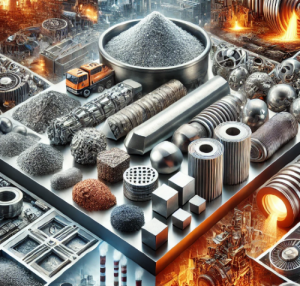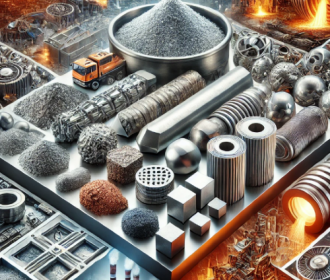Introduction
Refractory metals are characterized by their exceptional resistance to heat and wear, making them invaluable in high-temperature applications. These metals are often alloyed with other elements to enhance their properties and expand their range of applications. Below are some of the key alloys of refractory metals:

1. Tungsten Alloys
– Tungsten-Copper (W-Cu): This alloy combines the high melting point and density of tungsten with the electrical and thermal conductivity of copper. It is used in electrical contacts, heat sinks, and in components for aerospace and electronics where high conductivity and resistance to thermal expansion are required.
– Tungsten-Rhenium (W-Re): Adding rhenium to tungsten improves its ductility and high-temperature strength. It is used in thermocouples, aerospace components, and in the production of high-temperature filaments and electrical contacts.
Related reading: Properties and Applications of Tungsten Copper Alloy
2. Molybdenum-Based
– Molybdenum-Lanthanum (Mo-La): Also known as lanthanated molybdenum, this alloy is doped with small amounts of lanthanum oxide to improve its high-temperature strength and creep resistance. It is used in high-temperature furnaces, aerospace applications, and in the electronics industry.
– TZM Alloy (Titanium-Zirconium-Molybdenum): TZM contains small amounts of titanium and zirconium, which enhance its strength, hardness, and resistance to creep at elevated temperatures. TZM is widely used in die casting, extrusion dies, and high-temperature structural applications.
3. Tantalum-Based
– Tantalum-Tungsten (Ta-W): This alloy combines the corrosion resistance of tantalum with the high strength and hardness of tungsten. It is used in chemical processing equipment, where resistance to corrosive environments is critical, as well as in aerospace and military applications.
– Tantalum-Hafnium-Carbide (Ta-Hf-C): Known for having one of the highest melting points of any alloy, this combination is used in extreme temperature applications, such as rocket nozzles and in the aerospace industry.
Related reading: Tantalum Hafnium Carbide: Defying Extreme Conditions
4. Niobium-Based
– Niobium-Titanium (Nb-Ti): It is widely used in the production of superconducting magnets for applications in MRI machines, particle accelerators, and other scientific instruments. Niobium-titanium alloys offer excellent superconducting properties at low temperatures.
– C-103 Alloy (Niobium-Hafnium-Titanium): C103 contains hafnium and titanium, providing excellent strength and stability at high temperatures. It is used in rocket engines, aerospace components, and nuclear reactors.
5. Rhenium-Based
– Rhenium-Tungsten (Re-W): Rhenium is often alloyed with tungsten to improve its ductility and enhance its high-temperature performance. It is used in high-temperature thermocouples, rocket engines, and in the production of X-ray tubes.
– Rhenium-Molybdenum (Re-Mo): It is used in applications requiring high strength and corrosion resistance at elevated temperatures, such as in the aerospace and chemical processing industries.
6. Hafnium-Based
– Hafnium-Tantalum (Hf-Ta): Itis known for its high melting point and excellent corrosion resistance. It is used in high-temperature applications, including in nuclear reactors and aerospace components.
– Hafnium-Niobium (Hf-Nb): This alloy is used in aerospace applications and high-temperature environments where materials need to maintain strength and stability.
7. Carbide-Based
– Tungsten Carbide (WC): Often combined with cobalt to form tungsten carbide-cobalt alloys, this material is widely used in cutting tools, mining equipment, and wear-resistant parts due to its extreme hardness and wear resistance.
– Molybdenum Carbide (Mo₂C): Used in catalysts, wear-resistant coatings, and in high-temperature applications where both hardness and corrosion resistance are required.
Conclusion
These key alloys of refractory metals come with exceptional high-temperature performance, strength, and resistance to wear and corrosion. From aerospace to electronics and chemical processing, they are engineered to meet the most demanding specifications and continue to be critical in advancing technology and industrial capabilities. For more information, please check Advanced Refractory Metals (ARM).

Recent Comments